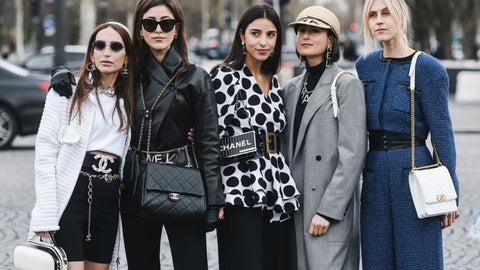This Week's Obsession: Is Resale Actually Fuelling Consumption?

Last month as luxury brands reported quarterly earnings, there was a good deal of talk about brand elevation strategies as aspirational shoppers shifted their spending away from traditional luxury items. While there were several theories as to why this is, there was no mentioned how price increases have aspirational shoppers spending their money on more affordable luxury items such as beauty or experiences.
Often the talk of brand elevation strategies feels like a euphemism for price increases. Back in January we wrote a blog, "Designer Bags: How High Will Prices Go?" To be fair at the time, we started to think that the price hikes of Chanel and Hermès this year were outrageous. But they are not the only ones to increase their prices as part of an elevation strategy. Where does this leave the aspirational luxury consumer?
Since Luxury goods are now priced way out of the reach of most people, but their resale value has allowed them to become investment pieces, like a fine wine or a piece of art. When you buy luxury, you may not just recoup the money you spend - you could get it back with interest. “Revenues from reselling luxury bags and clothing now add up to around $200bn a year,” reported The Economist last week. For the sensible (and mindful) shopper, the second hand market is beginning to eclipse buying new. It’s a trading floor.
The Trouble with Resale
The trouble is, although this is theoretically the circular econmy, there’s no sign that the second hand market is slowing the rise of the primary market. Indeed, it may be enabling it. “I can buy this because when I’m done I can just sell it on and buy something else.” Fashion’s biggest problem right now is over production and over consumption (ref Unfit, Unfair, Unfashionable, Hot or Cool Institute). A business owner of a second hand shopping site told me the other day that she was launching a marketing campaign around ‘everyday activism’. That she was positioning shopping from her site as a form of activism. This is troubling: shopping second hand is not activism. Shopping consciously is, second hand or otherwise.
In the Hot or Cool report (which was the inspiration for the Rule of Five campaign), the recommendation was that at least 20% of our wardrobe should consist of second hand items. The circular economy is such an important part of our journey to net zero, but we cannot shop our way out of the crisis, second hand or otherwise.
You can pick up a Chanel flap bag on HEWI right now for £6,000, representing a 40% discount on full price. That’s a no brainer if you’re in the market for Chanel, but not exactly activism.
Resale has become a popular trend in the fashion industry, with many consumers turning to second-hand clothing as a more sustainable option. But is resale truly sustainable in the long run? Here are what are considered the pros:
Reduction in Waste
One of the key benefits of resale is the reduction in textile waste. By extending the life of a garment through resale, it prevents it from ending up in a landfill. According to the Ellen MacArthur Foundation, extending the life of clothing by just nine months can reduce carbon, water, and waste footprints by 20-30% each.
Resource Conservation
Resale also helps conserve valuable resources such as water and energy. The production of new clothing requires significant amounts of water and energy, contributing to environmental degradation. By buying and selling second-hand items, consumers can help reduce the demand for new production and lessen the strain on these resources.
Changing Consumer Behavior
Resale encourages a shift in consumer behavior towards a more circular economy. Instead of the traditional linear model of take-make-dispose, resale promotes a circular approach where items are reused and recycled. This change in mindset is crucial for creating a more sustainable future.
Economic Benefits
From a financial perspective, resale can also be beneficial. Consumers can save money by purchasing pre-owned items at a lower cost than buying new. Additionally, selling items that are no longer needed can provide extra income and reduce the overall financial burden on individuals.
Conclusion
Overall, resale could offer a promising solution to the environmental and social challenges posed by the luxury industry as long as it isn't driving more consumption, if it is, and we think it may well be, that could negate many of the benefits.
Of course we feel that More's co-ownership model is superior to rental and resale. Although we advocate both for certain use cases. If you are going to wear something frequently or use daily you should buy and in this case we'd advocate by second-hand or reselling when you are no longer using it. For one off usage, especially for special occasions or try before you buy, we advocate rental. For items worn on rotation we advocate for co-ownership because our model is both a sharing and circular model. So less resources are used through sharing and the resources are taken care of to extend their life and retain their value so they can become the vintage pieces of tomorrow.
And you can monetise your share on our marketplace by loaning your share to other members of our trusted community. More Luxury Club is the next generation of retail. Join us today.




